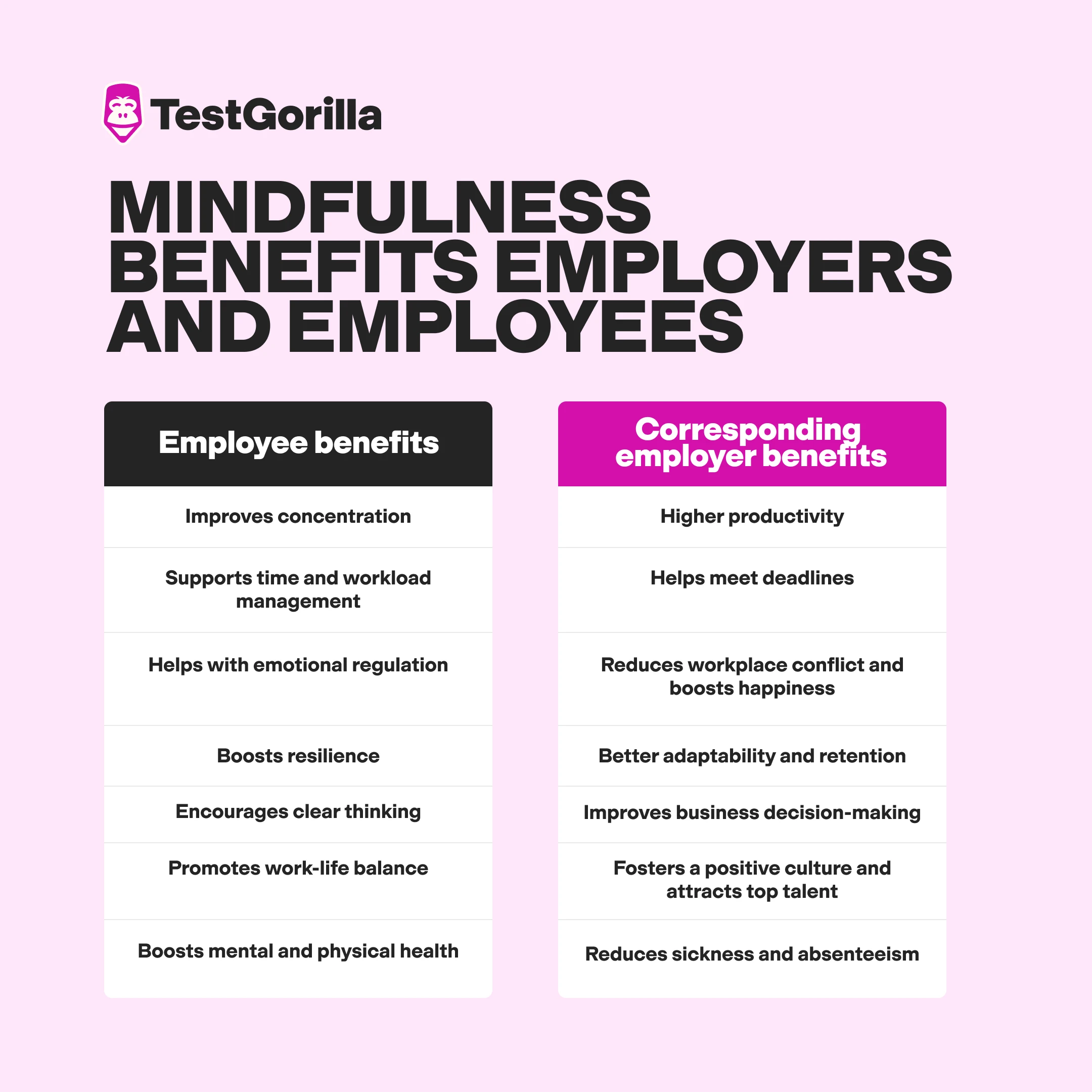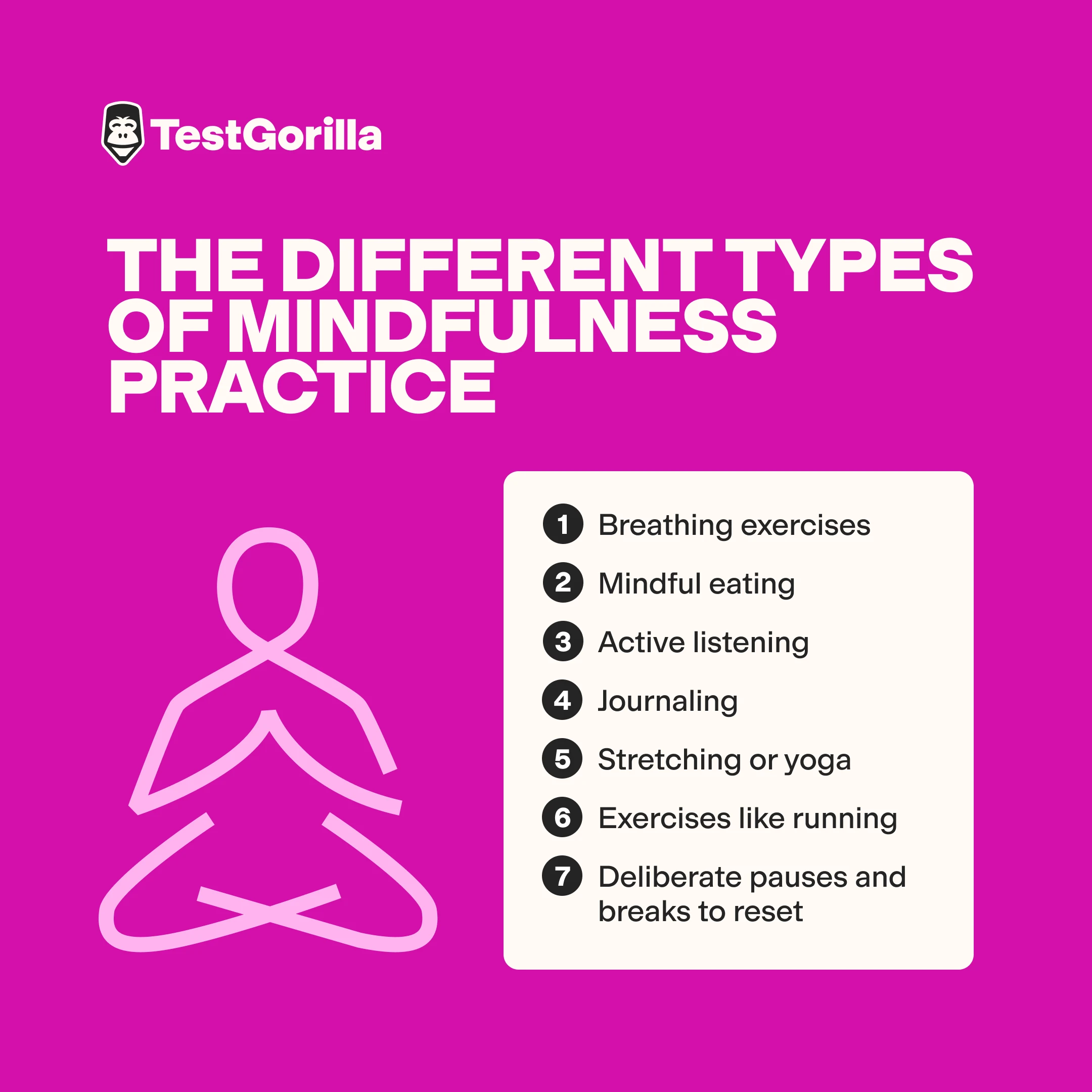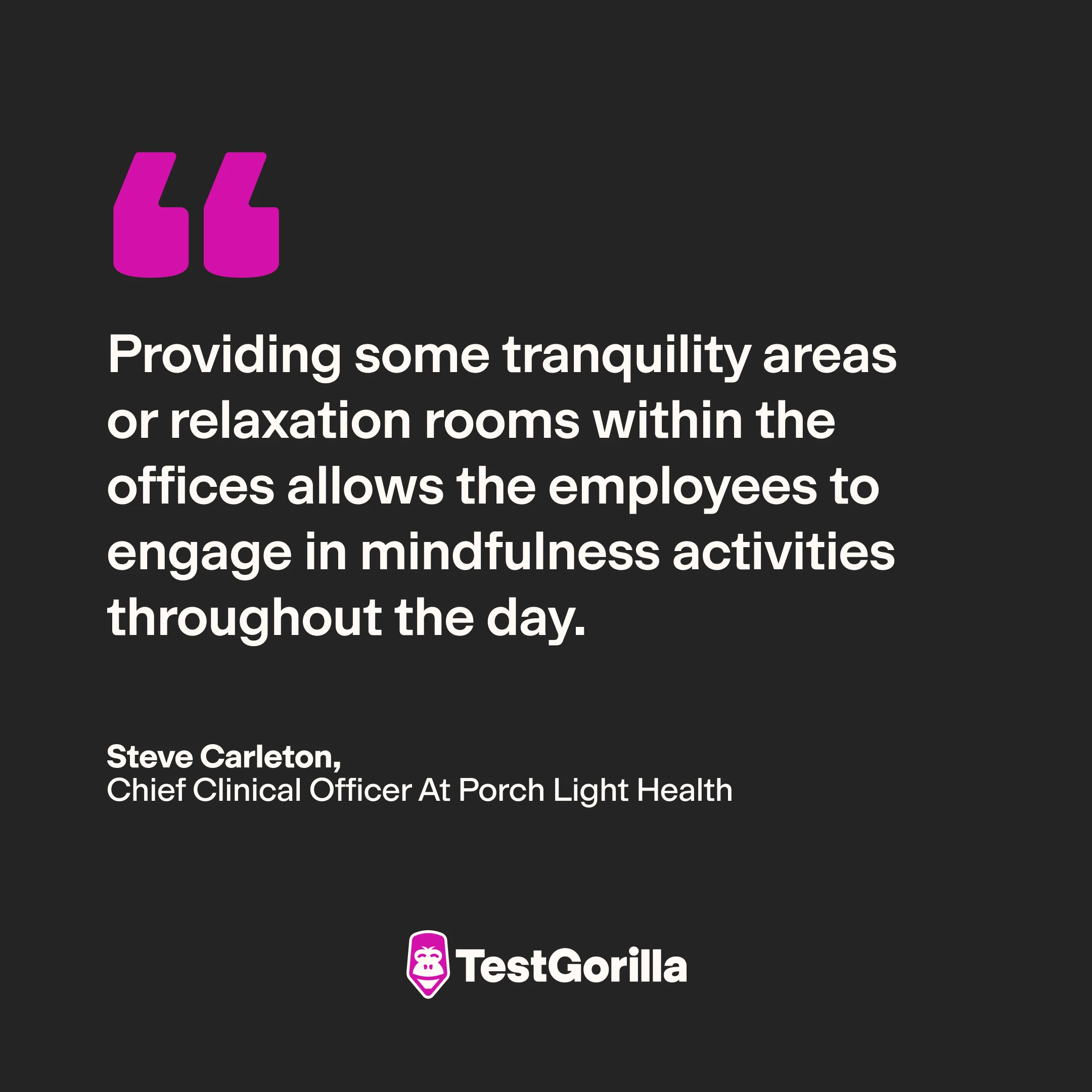The case for mindfulness at work: Benefits and best practices
Mindfulness isn’t just a trending buzzword – it’s a meaningful shift in how we approach work, and it’s here to stay.
Companies that embrace mindfulness often see better focus, reduced stress, and improved productivity. Ignore it, and you risk employee burnout, lower engagement, and a blow to your bottom line.
Despite this, many employers struggle to incorporate mindfulness. Some don’t really know what it means or how to practice it. Others brush it off as fluff or face pushback from those who view employees as mere resources rather than individuals with mental and emotional needs.
In this guide, we break down what mindfulness at work actually looks like and why it’s critical. We also share practical tips to incorporate mindfulness in your company.
Table of contents
What is mindfulness?
Mindfulness is the practice of staying fully present in a moment – being aware of your current thoughts, feelings, and surroundings without feeling distracted or overwhelmed. While mindfulness is commonly confused with meditation or zoning out, it's actually about bringing awareness into everything you do so you can stay calm, focused, and in control. You can practice mindfulness anywhere.
Meditation, in contrast, is usually a more formal practice that’s more concerned with intentional focus than awareness. It requires a setting that’s suitable for deep concentration – often on a singular goal.
While meditation is certainly one type of mindfulness practice, there are several others, including:
Breathing exercises
Mindful eating
Active listening
Journaling
Stretching or yoga
Exercises like running
Deliberate pauses and breaks to reset
What does it mean to be mindful at work?
Being mindful at work means fully focusing on the task at hand rather than getting preoccupied with distractions and noise, thinking about other tasks and projects, or worrying about the future. For example, listening attentively in meetings, pausing to reply to emails more thoughtfully, or meditating to tackle challenges with a clear head are all examples of mindfulness at work.
Why the sudden focus on mindfulness at work? 5 reasons
Mindfulness isn’t a new concept – we can trace it back to Buddhist practices from about 2,500 years ago. But, it’s recently gained traction as a tool to lower stress and boost mental health in the workplace.
Here’s why.
1. Shift in employee priorities since the COVID-19 pandemic
The COVID-19 pandemic put much of the world in lockdown. People stayed home, spent more time with loved ones, picked up new hobbies, and focused more on their physical and mental health. These practices helped them stay present, calm, and grounded during a tumultuous time.
What largely started as a response to the pandemic has become a permanent priority for many. In fact, Microsoft's 2022 Work Trade Index showed that 53% of employees were more likely to choose their health and well-being over work after the pandemic.
You'll see this even more in younger generations, who’ll soon make up most of the workforce. In a recent Forbes article, Tim Barker, CEO of Kooth Digital Health, shared that Gen Z employees care deeply about their mental health and well-being and speak openly about it.
2. Chronic stress and burnout
A Gallup poll showed that three in four US employees experience work-related burnout "at least sometimes," with a quarter experiencing it "very often" or "always." Gallup also found that 52% of employees reported stress as recently as the day before they took the poll – and linked stress to physical and mental health problems and lower productivity.
Healthline.com also revealed that American adults are more stressed today than people their ages were in the 1990s. Much of this is believed to be linked to the rise of technology, changes in family dynamics, and economic uncertainty.
According to Healthline, some of the best ways to manage stress are through better nutrition and mindfulness practices like yoga and exercise, which could contribute to the sudden comeback of mindfulness.
3. Information overload and second screening
Researchers at Stanford University explored how constantly switching between screens and digital devices affects the memory and attention of 80 young adults. They found that this sort of media multitasking led to poor memory retention and difficulty focusing on tasks.
Another blog called switching between different devices "second-screening" and suggested it could lead to:
Physical impacts like eye strain and neck pain
Reduced focus and attention span
More stress and anxiety
Sleep problems
Because so many people work digitally across multiple screens while being distracted by their phones, TVs, and other devices, people have realized there's a dire need to focus on mindfulness and minimize the negative consequences of digital overload.
4. Rise of remote and hybrid work
Gallup's study found that remote and hybrid workers were more stressed than their on-site counterparts.
Why? Well, recent research explained that remote and hybrid working has blurred the lines between careers and personal lives. Employees who don't have dedicated workspaces at home or are multitasking between work and caregiving responsibilities are less motivated and productive, feel more stressed, and experience poorer mental health.
The study outlined that mindfulness is a powerful practice that can help employees struggling with the challenges of working from home, which further explains its growing importance.
5. Link to business outcomes
There's no doubt now that today's employees are more prone to stress, burnout, anxiety, and a host of other mental health problems. This is costing employers.
An article in Forbes mentioned that missing work due to poor mental health costs the US economy over $47 billion per year in lost productivity. Employers have realized if they don't implement mindfulness at work, their businesses can take a real hit.
How does mindfulness benefit employers and employees?
Here's how mindfulness can benefit both employers and employees.
Employee benefits | Corresponding employer benefits |
✅Improves concentration Mindfulness practices like breathwork, meditation, and yoga can help employees become more present. This way, they can focus on tasks without being distracted by other thoughts or external interruptions. | ⭐Higher productivity Focused employees make fewer mistakes and complete their work more efficiently. A study by Aetna, a health insurance company, found that mindfulness practices helped employees increase productivity by 62 minutes per week, which they estimated was worth $3,000/employee/year. Another study by Headspace (a guided meditation app) showed that meditating helped participants improve their focus by 14% and significantly decreased mind-wandering. |
✅Supports time and workload management Engaging in journaling, time-blocking, or even just mindful pausing during the day can help employees better manage heavy workloads, use their time more efficiently, and reduce feelings of overwhelm. | ⭐Helps meet deadlines HR expert Yashna Wahal explains: "When employees can manage their time and prioritize tasks effectively and thoughtfully, they're more likely to meet company deadlines without compromising the quality of work." |
✅Helps with emotional regulation Mindfulness helps employees be self-aware, regulate their emotions, and better understand others – strengthening their happiness and relationships. For instance, workers who practice active listening or take mindful pauses before responding to heated debates can communicate better with their managers and colleagues. | ⭐Reduces workplace conflict and boosts happiness One study examined how mindfulness impacts conflict resolution styles in 197 nurse managers. Results showed that those who practiced mindfulness were more likely to collaborate or compromise, thus positively resolving conflict. Further research shows that mindfulness boosts employee happiness and that happy employees are 12% more productive. |
✅Boosts resilience Mindfulness exercises like gratitude journaling and mindful breathwork can equip employees with coping techniques for challenging situations like difficult projects and unexpected crises – building their resilience. | ⭐Better adaptability and retention Resilient employees are more likely to stick with your company through changes or tough times, giving you a significant competitive advantage. In fact, one study showed that mindfulness helped restaurant employees cope better with stress and prevented emotional exhaustion – both which contribute to employee turnover. |
✅Encourages clear thinking Mindfulness helps employees think clearly and logically rather than act on instinct. They might use mindfulness techniques to calm their minds, assess situations objectively, and carefully consider rational courses of action. | ⭐Improves business decision-making One study's results showed that participants who engaged in mindfulness activities were less likely to show cognitive biases in their decisions. Another blog by INSEAD Business School suggested that mindfulness results in heightened awareness, which helps employees problem-solve creatively, think through business decisions more thoroughly, and act more quickly. |
✅Promotes work-life balance Mindfulness can help employees successfully transition between work and personal time. For instance, starting the workday with journaling or meditation can help get employees ready to focus on their tasks. Mindful walks and stretches during the workday can give employees a quick break to recharge and reduce screen fatigue. Finally, ending the workday with yoga, breathwork, or meditation is a great way to switch off work, be fully present in other activities, and sleep better. A study of nearly 200 participants revealed that mindfulness practices positively affect people's ability to detach from work, manage work-family conflicts, and achieve better work-life balance. | ⭐Fosters a positive culture and attracts top talent If your employees are happier, less stressed, and satisfied with their work-life balance, you've nailed your company's culture. Corey Lewis, a co-founder and CEO of a health and fitness business, wrote an article in Forbes crediting the company's positive work environment, overall happiness, productivity, and employee satisfaction to mindfulness practices. Further, HR and hiring expert Yashna Wahal also shared: "Making mindfulness and work-life balance a priority is one of the best ways to attract top talent, especially from the new generation." |
✅Boosts mental and physical health Regular mindfulness practice has been shown to improve overall physical and mental health. A survey of 293 employees during COVID-19 found that those who practiced mindfulness were more comfortable with uncertainty, which decreased stress, anxiety, depression, and emotional burnout. Further, some preliminary evidence also suggests that mindfulness interventions can improve outcomes for stress-related diseases like psoriasis, irritable bowel syndrome, and PTSD. | ⭐Reduces sickness and absenteeism Recent research showed that mindfulness meditation improved employee engagement and retention, reduced absenteeism, and lowered employers' healthcare costs. In another compelling experiment, participants engaging in mindfulness-based programs showed a median of 13.9 general sick days at work compared with 32.9 sick days for the control group. |
5 best practices to introduce mindfulness at work today
Offering random wellness initiatives won't give you the full extent of the advantages of mindfulness.
Here are some best practices for incorporating mindfulness properly so you and your team can reap the long-term benefits.
1. Identify what your employees are struggling with – and determine the best mindfulness interventions
Figure out what your employees actually need so you're not wasting time and money on pointless practices. For example, an occasional yoga session won't cut it if they're struggling with a noisy work environment.
Seek this information through bi-annual surveys or focus groups or by actively involving employees in mindfulness initiatives. Several studies show that involving employees in wellness initiatives improves employee and business outcomes.
Additionally, consider using tools like behavioral observations, performance reviews, and self-assessments for more insights into areas that mindfulness can improve – like resilience, empathy, or stress.
Personality tests can supplement these insights. For instance, a 16 personalities test can show you which of your employees are Advocates (these personality types often struggle with handling stress).
Once you know what your employees struggle with, you can determine the best mindfulness interventions.
Research-based choices are great here.
For example, one study asked 1,400 gig workers to reflect on a time they wronged someone and found that those who practiced a kindness-focused meditation were more likely to improve their empathy levels than those who practiced other forms of meditation. So if your workers struggle with empathy, kindness-focused meditation might be a good intervention.
Another study showed that breathwork seems effective at reducing stress. So employees who struggle with stress might benefit from breathwork interventions.
Pro tip: Employees' needs keep evolving as they move through different life phases. Gather feedback about what's working and not working for them and what else they're looking for at least annually.
2. Offer varied mindfulness initiatives
Even if most of your employees struggle with just one area (say, stress), it’s important to offer various options so you can cater to different preferences and needs.
Here are some mindfulness practices you can offer and their benefits:
Breathwork and meditation: Helps reduce stress and improve focus during busy workdays
Gratitude journaling: Encourages positivity and promotes emotional resilience by having employees write down and reflect on things they’re grateful for
Outdoor walks: Lets employees take a break, get some fresh air, and reboot their headspace in the middle of a busy workday
Yoga and stretching: Combines physical movement with mindfulness, boosting health, creativity, and concentration
Mindful eating workshops: Teaches employees to pay attention to how and what they eat and helps them follow hunger cues to promote better health
Active listening sessions: Enhances team communication by teaching employees to listen without judgment or distractions
Creative activities: Provides a creative outlet for stress relief and encourages relaxation
Time management workshops: Helps employees manage their time more mindfully, reducing feelings of overwhelm and stress
Mindfulness apps: Offers easy-to-use tools like Headspace or Calm that employees can access anytime to recenter and refocus during stressful moments
Offering a healthy mix of these initiatives ensures every employee can find something that resonates with them.
3. Monitor employees' workload and provide support
You can't use mindfulness practices as a band-aid to fix deeper issues like excessive workload, late hours, and problems with work-life balance. Fail to address the root causes of stress, and your mindfulness efforts will fall flat.
Carefully monitor employee workloads to look for signs of overwork and address them. This could be an excessive number of shifts assigned, regular long hours, lack of holidays, or even consistently missed deadlines.
Conducting monthly one-on-one sessions with employees is another great way to check in and extend tailored support, such as mentorship, reduced workloads, and flexible hours.
One study examined how mindfulness, sleep quality, workload, and fatigue affect job performance in 168 working adults. The authors concluded that organizations must keep employees' workloads to a manageable degree to see the benefits of mindfulness at work.
4. Design mindful workspaces
Intentionally designed physical and virtual workspaces that create calm, focused environments make it easier for mindfulness to take effect.
Here are some design tips:
Create quiet zones or call-free spaces: Designate areas where employees can work in silence. This helps reduce stress and promote concentration.
Mindful virtual workspaces: Create no-meeting days, mandate quiet hours, and provide mindfulness tools – such as do-not-disturb features or Pomodoro timers – to help remote workers work more mindfully and disconnect when needed.
Introduce greenery: Add plants to the workspace or gift remote employees plants for their desks during onboarding. One study noted the presence of green plants in employees’ workspaces reduces anxiety and psychological stress across all age groups.
Natural lighting and open spaces: Maximize natural light in office settings or encourage remote workers to set up near windows. Plenty of research shows that natural light improves mood, happiness levels, and even physical health.
Mindful break areas: Set up designated areas where employees can take mindful breaks, naps, or engage in relaxing activities like reading.
Ergonomic design: Offer both on-site and remote workers ergonomic furniture – such as suitable chairs, sit-stand desks, or other personalized support – to ensure they’re comfortable at work.
"Providing some tranquility areas or relaxation rooms within the offices allows the employees to engage in mindfulness activities throughout the day." - Steve Carleton, Chief Clinical Officer at Porch Light Health
5. Lead by example
When leaders encourage mindfulness and actively participate in it themselves, employees are more likely to follow suit.
Senior employees taking time for mindful breaks or other practices signal that the workplace’s approach to mindfulness isn’t just lip service – it’s a priority.
Dr. Brooke Keels, Chief Clinical Officer at Lighthouse Recovery Texas, concurs:
To truly integrate mindfulness into the workplace culture, leaders should lead by example. When managers practice mindfulness and share their experiences, it encourages others to join.
That said, not every leader will resonate with the concept of mindfulness – some will dismiss it as fluff or even push back. Use a proactive approach by putting incoming managers and leaders through culture-add tests to see if their views on mindfulness align with what you're looking for. This way, you can hire leaders who genuinely embody mindfulness at work.
Boost mindfulness with a tailored approach for your company
Mindfulness helps reduce stress and burnout for employees while improving productivity, satisfaction, and retention for employers.
Despite its undeniable benefits, many companies miss the mark with their approach. To nail your mindfulness initiatives, use surveys and other tools to understand what your employees need. Then, tailor your offering with meditation, yoga, mindful eating, and various other practices.
Additionally, ensure employees have manageable workloads and good work-life balance – and design physical and virtual workspaces that promote focus and happiness. Finally, hire senior team members who lead by example and show that mindfulness is truly woven into the fabric of your company's culture.
Related posts
You've scrolled this far
Why not try TestGorilla for free, and see what happens when you put skills first.
Latest posts
The best insights on HR and recruitment, delivered to your inbox.
Biweekly updates. No spam. Unsubscribe any time.

Skills tests to hire the best
Our screening tests identify the best candidates and make your hiring decisions faster, easier, and bias-free.
Free resources
A step-by-step blueprint that will help you maximize the benefits of skills-based hiring from faster time-to-hire to improved employee retention.
With our onboarding email templates, you'll reduce first-day jitters, boost confidence, and create a seamless experience for your new hires.
This handbook provides actionable insights, use cases, data, and tools to help you implement skills-based hiring for optimal success
A comprehensive guide packed with detailed strategies, timelines, and best practices — to help you build a seamless onboarding plan.
This in-depth guide includes tools, metrics, and a step-by-step plan for tracking and boosting your recruitment ROI.
Get all the essentials of HR in one place! This cheat sheet covers KPIs, roles, talent acquisition, compliance, performance management, and more to boost your HR expertise.
Onboarding employees can be a challenge. This checklist provides detailed best practices broken down by days, weeks, and months after joining.
Track all the critical calculations that contribute to your recruitment process and find out how to optimize them with this cheat sheet.

















